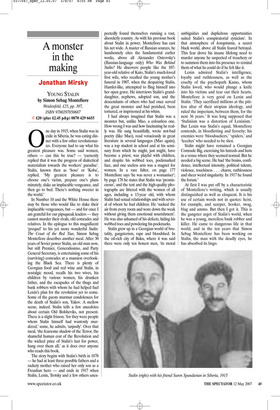A monster in the making
Jonathan Mirsky
YOUNG STALIN by Simon Sebag Montefiore Weidenfeld, £25, pp. 397, ISBN 9780297850687 ✆ £20 (plus £2.45 p&p) 0870 429 6655 One day in 1915, when Stalin was in exile in Siberia, he was eating dinner with a few other revolutionaries. Everyone had to say what his greatest pleasure was. Some said women, others — can this be true? — ‘earnestly replied that it was the progress of dialectical materialism towards the workers’ paradise’. Stalin, known then as ‘Soso’ or ‘Koba’, replied, ‘My greatest pleasure is to choose one’s victim, prepare one’s plans minutely, slake an implacable vengeance, and then go to bed. There’s nothing sweeter in the world.’ In Number 10 and the White House there may be those who would like to slake their implacable vengeances, but — and for once I am grateful for our pipsqueak leaders — they cannot murder their rivals, old comrades and relatives. In the epilogue to this magnificent ‘prequel’ to his yet more wonderful Stalin: The Court of the Red Tsar, Simon Sebag Montefiore describes another meal. After 30 years of Soviet power Stalin, an old man now, but still Premier, Generalissimo, and Party General Secretary, is entertaining some of his (surviving) comrades at a mansion overlooking the Black Sea. There is plenty of Georgian food and red wine and Stalin, in nostalgic mood, recalls his two wives, his children by various women, his drunken father, and the escapades of the thugs and bank robbers with whom he had helped fuel Lenin’s plan for the revolution yet to come. Some of the guests murmur condolences for the death of Stalin’s son, Yakov. A mellow scene, indeed. Stalin tells a few anecdotes about certain Old Bolsheviks, not present. There is a slight frisson, ‘for they were people whom Stalin himself had wantonly murdered,’ some, he admits, ‘unjustly’. Over that meal, ‘the fearsome shadow of the Terror, the shameful human cost of the Revolution and the wicked price of Stalin’s lust for power, hung over them all,’ as it does over anyone who reads this book.
The story begins with Stalin’s birth in 1878 — he had at least three possible fathers and a rackety mother who raised her only son as a Freudian hero — and ends in 1917 when pectedly found themselves running a vast, disorderly country. As with his previous book about Stalin in power, Montefiore has cast his net wide. A master of Russian sources, he handsomely cites the fundamental earlier works, above all Alexander Ostrovsky’s (Russian-language only) Who Was Behind Stalin? He discovers people like the 107year-old relative of Kato, Stalin’s much-loved first wife, who recalled the young mother’s funeral in 1907, when the despairing Stalin, Hamlet-like, attempted to fling himself into her open grave. He interviews Stalin’s granddaughter, nephews, adopted son, and the descendants of others who had once served the great monster and had perished, been tortured, or imprisoned at his whim.
I had always imagined that Stalin was a monster but, unlike Mao, a colourless one. How wrong I was and how fascinating he really was. He sang beautifully, wrote not-bad poetry (like Mao), read voraciously in great literature in several languages (Mao again), was a top student in school and at his seminary from which he might, just might, have become a priest, was playful with children, and despite his webbed toes, pockmarked face, and one useless arm was a magnet for women. In a rare falter, on page 177 Montefiore says ‘he was never a womaniser’; by page 178 he states that Stalin was ‘promiscuous’, and the text and the high-quality photographs are littered with the women of all ages, including a 13-year old, with whom Stalin had sexual relationships and with several of whom he had children. He ‘sucked the air from every room and wore down the weak without giving them emotional nourishment’. He was also ashamed of his defects, hiding his webbed toes and powdering his pockmarks.
Stalin grew up in a Georgian world of brutality, gangsterism, rape and bloodshed. In the oil-rich city of Baku, where it was said there were only ten honest men, ‘its moral ambiguities and duplicitous opportunities suited Stalin’s conspiratorial cynicism’. In that atmosphere of konspiratsia, a secret black world, above all Stalin feared betrayal. This fear drove his insane lifelong need to murder anyone he suspected of treachery or to summon them into his presence to remind them of what he could do if he felt like it.
Lenin admired Stalin’s intelligence, loyalty and ruthlessness, as well as the cruelty of the psychopath Kamo, whom Stalin loved, who would plunge a knife into his victims and tear out their hearts. Montefiore is very good on Lenin and Stalin. ‘They sacrificed millions at the pitiless altar of their utopian ideology, and ruled the imperium, between them, for the next 36 years.’ It was long supposed that ‘Stalinism was a distortion of Leninism.’ But Lenin was Stalin’s equal, Montefiore contends, in bloodletting and ferocity; his enemies were ‘bloodsuckers,’ ‘spiders,’ and ‘leeches’ who needed to be shot.
Stalin might have remained a Georgian Comrade Big, exercising his hatreds and lusts in a venue where they seemed normal. But he needed a big scene. He had ‘the brains, confidence, intellectual intensity, political talents, violence, touchiness . . . charm, ruthlessness and sheer weird singularity. In 1917 he found the forum.’ At first I was put off by a characteristic of Montefiore’s writing, which is usually distinguished as well as eloquent. It is his use of certain words not in quotes: heist, for example, and scarper, hooker, swag, blag and ammo. But then I got it. This is the gangster argot of Stalin’s world, when he was a young, merciless bank robber and killer. He came to dangerous life in that world, and in the ten years that Simon Sebag Montefiore has been working on Stalin, the man with the deadly eyes, he has absorbed its lingo.










































































 Previous page
Previous page